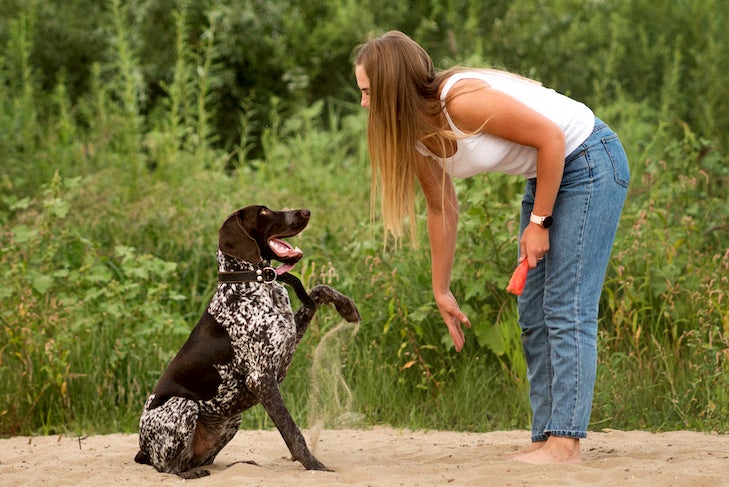Master Important Commands: Efficient Dog Training Facilitated
Effective pet dog training is an essential facet of accountable pet ownership, and grasping crucial commands offers as the foundation for a harmonious partnership in between trainer and pet dog. Comprehending the subtleties of canine actions and the training process is crucial; however, the journey to a trained dog often offers unanticipated difficulties that need interest.
Comprehending Your Canine's Habits
To understand the nuances of effective pet dog training, it is vital to damage down and examine your dog's habits. Dog training. Understanding the inspirations behind your canine's activities is critical; behaviors can originate from reaction, concern, exhilaration, or a need for interest. By observing your pet dog in different situations, you can determine patterns that might indicate underlying feelings or demands
For circumstances, a pet that barks excessively might be revealing dullness, stress and anxiety, or a requirement for social interaction. On the other hand, a pet that shows damaging actions could be seeking stimulation or relief from stress and anxiety. Recognizing these triggers allows you to tailor your training strategy properly.
In addition, it is essential to consider the pet dog's breed attributes, as they can influence behavior significantly. Some breeds are predisposed to particular qualities, such as herding or safeguarding impulses, which can affect their reactions to particular stimuli.
Last but not least, consistency in your feedbacks to your pet's habits promotes a better understanding in between you and your family pet. This mutual comprehension is fundamental for developing trust and promoting an effective training process that nurtures both behavioral adjustment and favorable reinforcement.
Crucial Commands to Instruct
Showing crucial commands is an essential facet of effective pet dog training, providing the structure for a mannerly and responsive pet dog. These commands not only improve communication between the proprietor and the pet dog yet additionally make sure safety and security in different settings.
The most vital commands consist of "Sit," which motivates your pet to stay fixed and calm; "Stay," which enhances the idea of continuing to be in one location until released; and "Come," which is crucial for remembering your pet dog from possibly dangerous scenarios. "Down" instructs pets to lie down, promoting leisure and control, while "Leave it" assists stop dogs from getting damaging or undesirable things.
" Heel" is an additional important command that motivates your dog to walk closely next to you, enhancing leash good manners. Finally, "No" works as an essential boundary-setting command, aiding to correct undesirable habits.
Training Strategies for Success
Efficient pet dog training depends greatly on using a range of strategies that provide to both the pet's discovering style and the proprietor's training goals. One crucial technique declares support, which includes satisfying preferred habits with treats, appreciation, or play. This approach motivates the pet to duplicate browse around this site those habits, promoting a solid bond in between owner and family pet.

An additional efficient method is remote control training, where a distinct sound, made by a remote control, marks the specific moment a canine carries out a wanted activity. This accurate timing aids pet dogs connect the behavior with the incentive, enhancing their understanding.
Uniformity is important in all training methods. Developing clear commands and maintaining the exact same signs assists the canine understanding assumptions more quickly. In addition, short, engaging training sessions protect against dullness and increase retention.
Integrating socialization opportunities is also vital. Exposing dogs to numerous atmospheres, individuals, and other animals assists them develop self-confidence and adaptability.
Lastly, patience plays a considerable duty in successful training - Dog training. Each pet dog learns at their own pace, and recognizing this can result in an extra satisfying training experience for both the owner and the pet. Executing these strategies will establish the structure for reliable pet dog training
Common Difficulties and Solutions
In spite of the most effective training strategies, pet owners usually run into usual difficulties that can prevent progress. One prevalent issue is variance in commands and hints. When family members make use of various commands for the exact same actions, it confuses the pet, causing irregular feedbacks. The service lies in establishing a unified method among all family members, making certain that every person uses the exact same terms and signals.

In addition, some pets might show stubbornness or lack motivation. This can commonly be resolved by integrating favorable click for more reinforcement strategies, such as deals with or praise, to urge wanted actions. Customizing rewards to what your pet dog finds most motivating can dramatically enhance their engagement.
Finally, fear or anxiousness can restrain progression in training. Acknowledging signs of stress and anxiety and readjusting the training rate as necessary is critical. Utilizing gradual direct exposure to feared stimuli can assist develop self-confidence gradually, promoting a much more reliable training experience.
Keeping Uniformity and Perseverance
Uniformity and persistence are paramount in pet dog training, as they create the structure for accomplishing enduring behavior adjustments. Dogs thrive on regular and clear assumptions; thus, preserving a regular technique in commands, benefits, and adjustments is necessary. When fitness instructors utilize the same cues and signals reliably, canines are better able to realize what is being asked of them. Variance can result in complication and frustration, undermining the training procedure.
Dogs, much like people, have differing discovering rates and may not grasp commands immediately. Positive support plays a vital role below, gratifying wanted actions and assisting to foster a relying on partnership between the dog and fitness instructor.
Conclusion
Mastering necessary commands is fundamental to effective canine training, promoting improved communication and enhancing positive actions. The application of favorable support techniques, combined with uniformity and perseverance, significantly boosts the training experience for both the pet dog and handler. Resolving typical difficulties with useful services even more supports the training procedure. Ultimately, a trained dog not just exhibits etiquette however likewise develops confidence, adding to an unified connection between the pet and its proprietor.